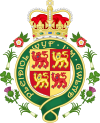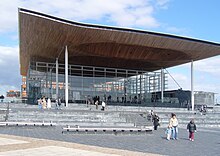Politics in Cardiff
This articleappears to beslanted towards recent events.(June 2019) |
| This article is part ofa serieswithin the Politics of the United Kingdomon the |
| Politics of Wales |
|---|
 |
Politics of Cardiffrefers to the political representation of the city ofCardiff,capital ofWales.Cardiff is represented politically at a local, Wales andUnited Kingdomlevel and previously at theEuropeanlevel.
Political representation
[edit]Cardiff is covered by four parliamentary constituencies which form the electoral basis for elections to theParliament of the United Kingdomand theSenedd (Welsh Parliament).
The constituencies and their current representatives in theHouse of Commonsare:
- Cardiff Central:Jo Stevens(Labour Party)[1]
- Cardiff North:Anna McMorrin (Labour Party)[2]
- Cardiff South and Penarth:Stephen Doughty(Labour Party)[3]
- Cardiff West:Kevin Brennan(Labour Party)[4]
Famous politicians who have represented Cardiff constituencies includeJames Callaghan,a formerPrime Ministerwho held his constituency seat for over forty years.Rhodri Morgana formerFirst Minister,was previously MP forCardiff West,as hadGeorge Thomas, 1st Viscount Tonypandy,who served asSpeaker of the House of Commonsbetween 1976 and 1983.
Senedd
[edit]
TheSenedd(Welsh Parliament;Welsh:Senedd Cymru;formerly known as the National Assembly for Wales) has been based inCardiff Baysince its formation in 1999. The building which is now known as theSenedd buildingwas opened on 1 March 2006, bythe Queen.The executive and civil servants of theWelsh Governmentare based in Cardiff'sCathays Parkwhile the Members of the Senedd, the Senedd Parliamentary Service and Ministerial support staff are based in Cardiff Bay. Cardiff elects four constituency Members of the Senedd (MSs) to the Welsh Parliament, with the individual constituencies for the Welsh Parliament being the same as for the UK Parliament. All of the city's residents have an extra vote for theSouth Wales Centralregion which increases proportionality to the Welsh Parliament. The most recent Welsh Parliament elections were held on 3 May 2016.
As with the United Kingdom Parliament, Cardiff is split into four constituencies:
- Cardiff Central:Jenny Rathbone(Labour)
- Cardiff North:Julie Morgan(Labour)
- Cardiff South and Penarth:Vaughan Gething(Labour)
- Cardiff West:Mark Drakeford(Labour)
TheSouth Wales CentralSenedd region elects four Members of the Senedd to serve the area covered by Cardiff,Rhondda-Cynon-Tafand theVale of Glamorganlocal authority areas. These are currently:
- Joel James(Conservative)
- Andrew R. T. Davies(Conservative)
- Rhys ab Owen(Plaid Cymru)
- Heledd Fychan(Plaid Cymru)
Local government
[edit]

Cardiff had an elected town council from 1836. In 1889 Cardiff became a county borough, represented by 40 elected councillors and aldermen on Cardiff County Borough Council[5](commonly referred to as Cardiff City Council after the town gained city status in 1905). Representation increased to 52 after 1922.[6]
Between 1974 and 1996 the council became a second tier district council ofSouth Glamorgan.Cardiff voters also elected councillors toSouth Glamorgan County Council.
Since local government reorganisation in 1996, Cardiff has been governed by the City and County Council of Cardiff, which is based atCounty Hallin Atlantic Wharf, Cardiff Bay. Voters elect 75 councillors every four years, with the next elections due to be held in 2016.
The council was run by a Labour majority administration between 1995 and 2004. The Liberal Democrats ran a minority administration from 2004-2008. In 2012 Labour regained control of the council.
As of2019,Labourhave 38 councillors, theLiberal Democratshave 11, theConservativeshave 21, Cardiff West Independents have 4, with 1 from Heath & Birchgrove Independents. The Leader of the Council, Cllr Huw Thomas, is from theLabour Party.
Community Councils
[edit]There are currently sixcommunity Councilsin Cardiff:
- Lisvane (10 seats)[7]
- Old St. Mellons (9 seats)[8]
- Pentyrch (13 seats)[9]
- Radyr & Morganstown (13 seats)[10]
- Tongwynlais (9 seats)[11]
- St. Fagans (9 seats)[12]

Elections are held every five years. The last contested elections would have been held in May 2017, had there been more candidates than available seats. For example, only six candidates stood in St Fagans for nine seats,[13]whilst in Radyr & Morganstown eight candidates stood for thirteen seats.[14] In Pentyrch, ten candidates (6 Ind, 3 Lab, 1 Plaid Cymru) put themselves forward for thirteen seats, so all were elected unopposed.[15]
Community Councils have the ability to co-opt new Councillors between elections to fill vacancies if not enough candidates stand for election. Alternatively, a By-election will be called if ten or more registered electors within the relevant ward call for one after a Notice of Casual Vacancy is published.[16]
In March 2020, there were twelve Co-opted Community Councillors in Cardiff (3 on Lisvane, 4 on Pentyrch, 3 on St Fagans, 1 on Tongwynlais and 1 on Radyr & Morganstown) as well as three vacant seats (2 on Old St Mellons and 1 on Pentyrch) on the six Council websites.
See also
[edit]References
[edit]- ^"Jo Stevens MP, Cardiff Central".Retrieved11 September2015.
- ^"Anna McMorrin MP, Cardiff North".Retrieved9 June2017.
- ^"Stephen Doughty MP".TheyWorkForYou.com.Retrieved6 February2013.
- ^"Kevin Brennan MP".TheyWorkForYou.com.Retrieved17 October2008.
- ^B. W. Row, F. G. Squire (1974),Cardiff 1889-1974 - The Story of the County Borough,The Corporation of Cardiff, City Hall, Cardiff, p. 16
- ^B. W. Row, F. G. Squire (1974),Cardiff 1889-1974 - The Story of the County Borough,The Corporation of Cardiff, City Hall, Cardiff, p. 42
- ^"Your Local Councillors".LisvaneCommunity Council.Retrieved26 March2020.
- ^"Councillors".Old St MellonsCommunity Council.Retrieved26 March2020.
- ^"Councillors".PentyrchCommunity Council.Retrieved26 March2020.
- ^"Councillors and staff".Radyr&MorganstownCommunity Council.Retrieved26 March2020.
- ^"Community Councillors".TongwynlaisCommunity Council.Retrieved26 March2020.
- ^"Your Community Councillors".St FagansCommunity Council.Retrieved26 March2020.
- ^"Your Community Councillors".St FagansCommunity Council.Retrieved28 March2020.
- ^"Community Council vacancies".Radyr&MorganstownCommunity Council. Archived fromthe originalon 8 June 2017.Retrieved28 March2020.
- ^"Elections".PentyrchCommunity Council.Retrieved28 March2020.
- ^"By-elections and Casual Vacancies".Vale of Glamorgan Council.Retrieved28 March2020.

